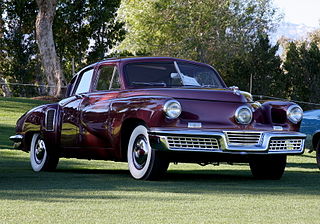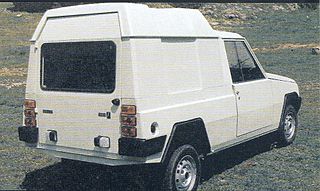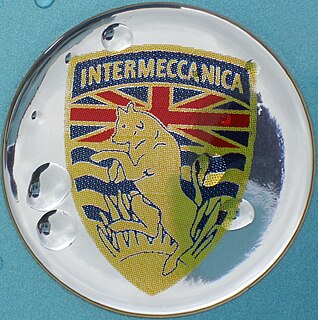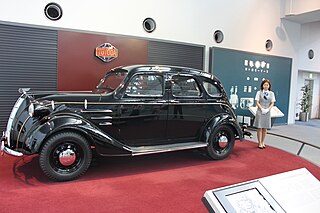
Jeep is a brand of American automobiles that is a division of FCA US LLC, a wholly owned subsidiary of the Italian-American corporation Fiat Chrysler Automobiles. Jeep has been a part of Chrysler since 1987, when Chrysler acquired the Jeep brand, along with remaining assets, from its previous owner: American Motors Corporation (AMC).

The Tucker 48 is an automobile conceived by Preston Tucker and briefly produced in Chicago in 1948. Only 51 cars were made before the company ceased operations on March 3, 1949, due to negative publicity initiated by the news media, a Securities and Exchange Commission investigation and a heavily publicized stock fraud trial. Speculation exists that the Big Three automakers and Michigan Senator Homer S. Ferguson also had a role in the Tucker Corporation's demise.

Preston Thomas Tucker was an American automobile entrepreneur.

Packard was an American luxury automobile marque built by the Packard Motor Car Company of Detroit, Michigan, United States. The first Packard automobiles were produced in 1899, and the last Detroit-built Packard in 1956, when they built the Packard Predictor, their last concept car.

Studebaker was an American automobile manufacturer based in South Bend, Indiana. Founded in 1852 and incorporated in 1968 as the Studebaker Brothers Manufacturing Company, the firm was originally a producer of wagons for farmers, miners, and the military.

Cord was the brand name of an American luxury automobile company from Connersville, Indiana, manufactured by the Auburn Automobile Company from 1929 to 1932 and again in 1936 and 1937.
The Ace was an American-assembled car made in Ypsilanti, Michigan by the Apex Motor Car Company, which was reorganized as the Apex Motor Corporation in 1921. The initial batch of cars assembled were sent to Seattle, Washington dealer FE Earnest, who had the idea for the Ace after he was unable to secure a steady supply of new cars for his dealership.

Adler was a German automobile and motorcycle manufacturer from 1900 until 1957. Adler is German for eagle.

Automotive design is the process of developing the appearance, and to some extent the ergonomics, of motor vehicles, including automobiles, motorcycles, trucks, buses, coaches, and vans.

The Hudson Italia is an automobile styling study and a limited production two-door compact coupé that was produced by the Hudson Motor Car Company of Detroit, Michigan, in cooperation with Carrozzeria Touring of Italy, and subsequently marketed by American Motors Corporation during the 1954 and 1955 model years. Designed by Frank Spring with input from Carlo Felice Bianchi Anderloni of Carrozzeria Touring, and introduced 14 January 1954, the Italia was based on the Hudson Jet platform and running gear, but with a unique body and interior.

MAVA Company was the Greek importer of Renault automobiles. In 1979, it decided to enter the car-production business introducing a passenger-utility car, a type then very popular in Greece for tax cetagorization reasons. MAVA assigned the creation of the car to Georgios Michael, a Greek designer credited with the design of Neorion Chicago, as well as that of several other Greek vehicles. Michael and his team completed the development and prototype construction in record-time and the car, named Farma, was introduced the same year. MAVA had insisted that the car should be presented as a "Renault model" and thus the prototype was tested and approved by the French company. The Farma, accordingly bearing the Renault logo, was produced in a variety of versions, including "passenger" and "van" types. It had a 4-cylinder 845 cc 34 hp (25 kW) engine and could reach a top speed of about 110 km/h (68 mph). A total of 4500 were built, including the "pure jeep-type" Σ model introduced in 1983, and some minor face-lifts. The attractive car had also received a modest publicity in the European press. By 1985, the Greek law had changed affecting the market for this type of vehicles, thus making their production unprofitable. Michael and his team then worked on a new model; the much more advanced new Farma Change was introduced in 1985. By that time, though, MAVA had scrapped the whole project and only one car, the prototype of the new model, was built.

Intermeccanica is an automobile manufacturer, founded in Torino, Italy, in 1959 by Frank Reisner. It subsequently moved first to the United States, then to Canada, and is currently headed by Frank's son, Henry Reisner.

The A1 was the first prototype passenger car built by the company that became Toyota. It was redesigned and put into production as Toyota's first production cars, the AA sedan and the AB cabriolet. These were succeeded by the similar AE, AC and BA sedans.
Playboy Motor Car Corporation was a Buffalo, New York-based automobile company, established in 1947. The company only made 99 cars including 1 prototype, 97 finished serial numbered production cars, as well as 1 unfinished car numbered 98 which has survived with zero miles on the odometer before going bankrupt in 1951.
Royston Charles Lunn was an engineer in the automotive industry. He had forty-one years in the design development and production of vehicles and most notably served as the head of engineering at American Motors Corporation (AMC) from 1971 to 1987. Lunn is credited as being the "father of the modern SUV" and "the godfather of the Ford GT40."

The automotive industry in the United States began in the 1890s and, as a result of the size of the domestic market and the use of mass production, rapidly evolved into the largest in the world. However, the United States was overtaken as the largest automobile producer by Japan in the 1980s, and subsequently by China in 2008. The U.S. is currently second among the largest manufacturer in the world by volume, with approximately 8-10 million manufactured annually. Notable exceptions were 5.7 million automobiles manufactured in 2009, and peak production levels of 13-15 million units during the 1970s and early 2000s.

The Commonwealth Motors Corporation was a luxury auto company that produced cars from 1917 to 1922. The company was founded in Chicago as Partin-Palmer company in 1913, but in 1915 got into financial trouble. So, in 1917, the name was changed to Commonwealth, and production was moved to Joliet, Illinois.

The Three Musketeers is a nickname given to a team of three famous Studebaker engineers, Frederick Morrell Zeder, Owen Ray Skelton, and Carl Breer. These three men would later become the core engineers that started the Chrysler Corporation. Chrysler surrounded himself with the finest engineers available when he started Chrysler Corporation and the Three Musketeers were such people.

Ralf-Stetysz was the marque of one of the earliest Polish car manufacturers begun in France and transferred to Poland in the 1920s. It was formed in 1924, when Count Stefan Tyszkiewicz, an inventor and mechanical engineer, started a small automotive firm "Automobiles Ralf Stetysz" in Boulogne-Billancourt near Paris. The name was an acronym in Polish of the name "Rolniczo Automobilowo-Lotnicza Fabryka Stefana Tyszkiewicza" - "Agricultural-Automobile-Aero Factory of Stefan Tyszkiewicz").




















